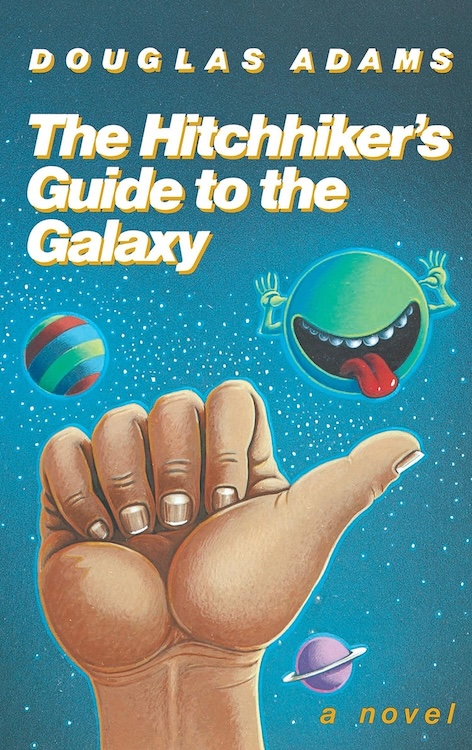posted: November 25, 2023
tl;dr: Don’t panic, instead read this post...
Author Douglas Adams got it right: the best life advice ever is just two words: “Don’t Panic!”
For the sake of convenience and prominence, that advice appears right on the cover of the fictional “Hitchhiker’s Guide to the Galaxy,” as described in Adam’s novel The Hitchhiker’s Guide to the Galaxy. Strangely, most English editions of Adams’s novel do not feature those two words of advice on the cover, although that may be another one of his jokes. Or maybe it is meant to differentiate the two books with the same title, although they are also differentiated by the fact that one actually exists in our world (Adams’s book) and one does not (the book Adams describes).

The front cover of one of my favorite books, The Hitchhiker's Guide to the Galaxy by Douglas Adams
I started reading Douglas Adams’s five-book “Hitchhiker’s Guide” trilogy as a teenager. I already had a strong inclination towards not panicking, but Adams’s book crystallized it for me. I try to maintain a steady, even-keeled demeanor even in the most challenging, surprising situations. Another term for this is “coolness under pressure”. That, to me, is the most important meaning of “cool”, a word that unfortunately, like the word “free”, has too many meanings to be well-understood in all contexts. Few people would call me “cool” for my style of dress or my knowledge of popular culture, but I do get compliments for how I act under pressure and in uncertain, chaotic situations. “Don’t panic!” is the same concept as “Be Cool!”, although because of the multiple meanings of “cool”, the former is a more specific command and hence better advice.
How does one not panic when a surprising, potentially harmful situation arises? Often the situation induces a surge of adrenaline, to bias the more primitive parts of the brain towards a fight-or-flight reaction. One of those responses may indeed be the best action to take, or it may not. The response should only be chosen after allowing other parts of the brain, especially the more-evolved, higher-level aspects of cognition to rationally assess the situation, consider all the various options, and then choose the response that is most likely to produce the best possible outcome. It is especially important to apply that response in the appropriate amount, and not to overdo it.
Another place where I recently ran across the sage advice of “Don’t panic!” is in an instructional manual for riding a motorcycle. A family member is learning to ride, and I had been offering lots of tips, among them the importance of operating the controls smoothly and without sudden movements. If you slam on the brakes, quickly rev the engine to the max, or push strongly on the handlebars, you can easily cause the bike to go down, which can make a bad situation worse. My instructee then sent me the image below, which presents a sudden, challenging situation and then offers those time-proven two words of advice: “Don’t panic!”:

Sage words of advice from a motorcycle riding instructional manual
There are prominent examples of not panicking that can be used as inspiration, with some having been turned into popular movies. The astronauts and ground crew of the Apollo 13 mission did not panic when an oxygen tank ruptured on their flight: the incident was first reported with the now-famous words “Houston, we’ve had a problem.” When a flock of birds knocked out both engines on US Airways Flight 1549 shortly after takeoff from LaGuardia Airport, the crew did not panic and successfully landed the plane in the Hudson River, saving the lives of all aboard. Remaining cool under pressure was critical in both situations.
The natural human tendency, however, is to panic, perhaps because of the adrenaline, or perhaps because of the perceived need to immediately start doing something in response. This all-too-common response is summarized by one of my favorite short rhymes of bad advice:
When in trouble or in doubt
Run in circles, scream and shout
(Also see My most challenging field failure ever.)
Unfortunately, that’s exactly what political leaders in the United States and worldwide did when the COVID-19 pandemic arose. The lockdowns, extended school closures, business shutdowns, vaccine mandates, and vaccine passports were all an over-reaction that ultimately did more overall harm than good. Excess deaths are still elevated, and life expectancy in the United States is still falling, three years after the onset of what is now an endemic virus. A much better policy would have been the “focused protection” of the at-risk populations as described in The Great Barrington Declaration, but that possibility was quickly and devastatingly taken down by Drs. Collins and Fauci. In June of 2020 I posted Living with the virus, because that’s what I thought the United States would do. Boy was I wrong. We’re still running in circles, screaming and shouting. The human tendency towards a panicked reaction can be, and will continue to be, exploited by bad actors looking to harm this country in the future.
Being an engineer may help me not panic, as engineers are trained to solve problems by applying the laws of science, mathematics, and logic. But there’s nothing preventing anyone from learning how to react coolly under pressure. The main thing that is required is to ignore the adrenaline jolt and calmly think through the situation at hand. Then and only then, take action. Be like Captain Sully of Flight 1549.